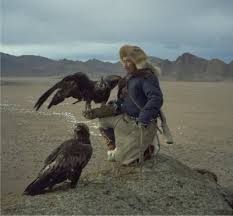But not all eagles fit this
stereotype: some are just small balls of feathers content to flap short
distances, dining on insects or even fruit. The Crested Serpent Eagle, for
instance, is no bigger than a pigeon and spends its days walking and climbing
through its African forest home in search of snakes. And the African Vulturine
Fish-Eagle is primarily a vegetarian, eschewing meat in favor of rich oil palm
fruits.
Overall, scientists recognize four groups of
eagles: The world’s 12 species of “serpent eagles” (also called “snake-eagles”)
typically perch on trees and feed on snakes, frogs, and lizards. The six
buzzard-like eagles are forest-dwelling giants, such as the Harpy and
Philippine eagles, and prey on large mammals like deer
Behind this extraordinary
reverence, however, is the even more remarkable story of how Earth’s 59 species
of eagles live their high-flying lives. That story is told in the NATURE
program Eagles, which gives a rare
bird’s-eye-view of these masters of the sky.Eagles documents
the stunning acrobatics and the ferocious hunting skills that have made these
birds the nobility of feathered society, from the plains of Africa and the
rivers of Alaska to the forests of the Philippines .
Eagles
Introduction
Their fierce portraits stare out from cave
paintings crafted by long-forgotten Stone Age masters. Their hooked beaks and
deadly claws have adorned flags that led armies from Rome to Germany into
battle. The spot on which one landed dictated to the ancient Aztecs the place
where they were to build a cityIntroduction
We venerate them as living
symbols of power, freedom, and transcendence. In some religions, high-soaring
eagles are believed to touch the face of God. Legend holds that Mexico’s Aztecs
so revered the birds that they built Tenochtitlan, their capital, at the spot
where an eagle perched on a cactus.
No comments:
Post a Comment